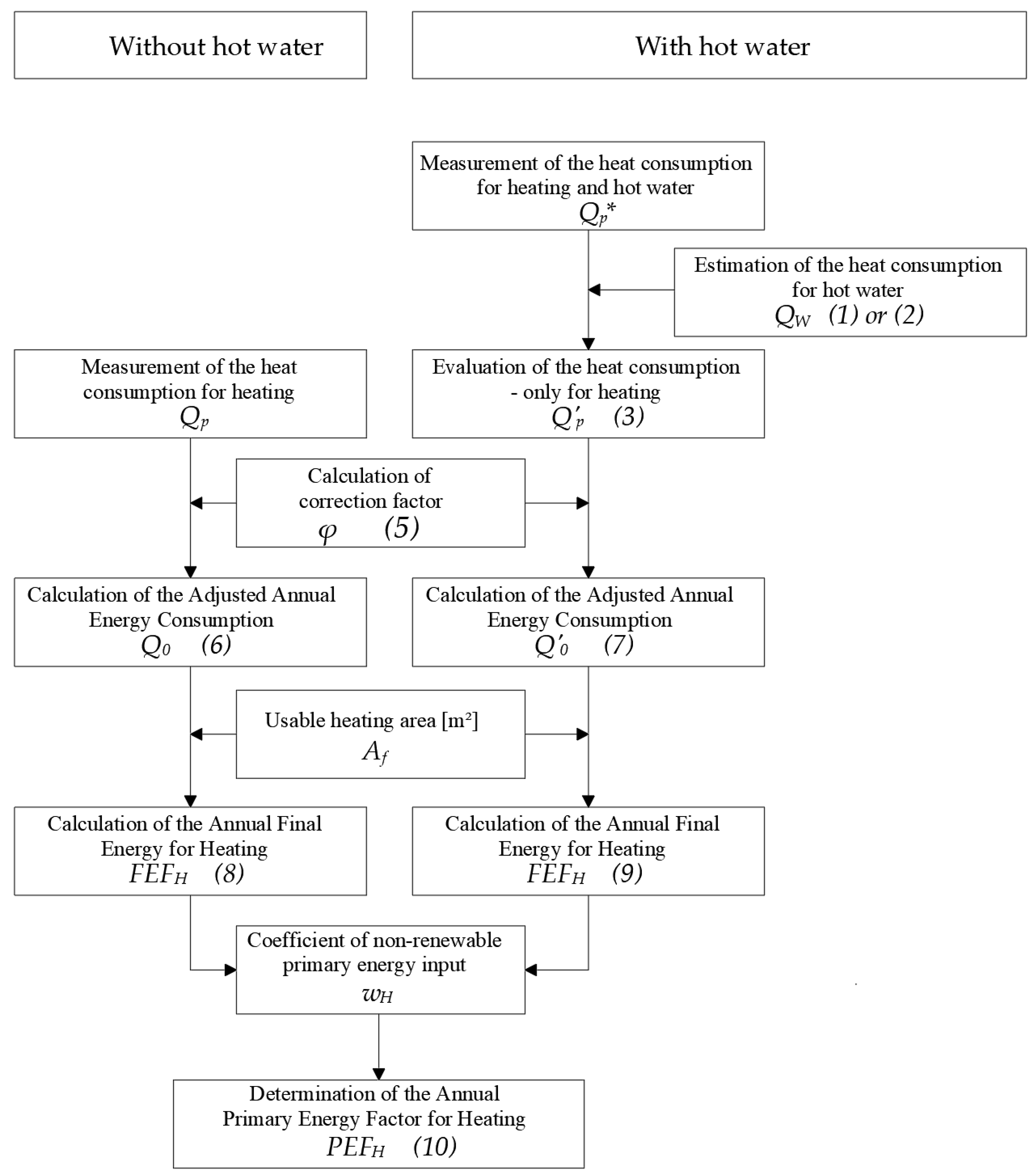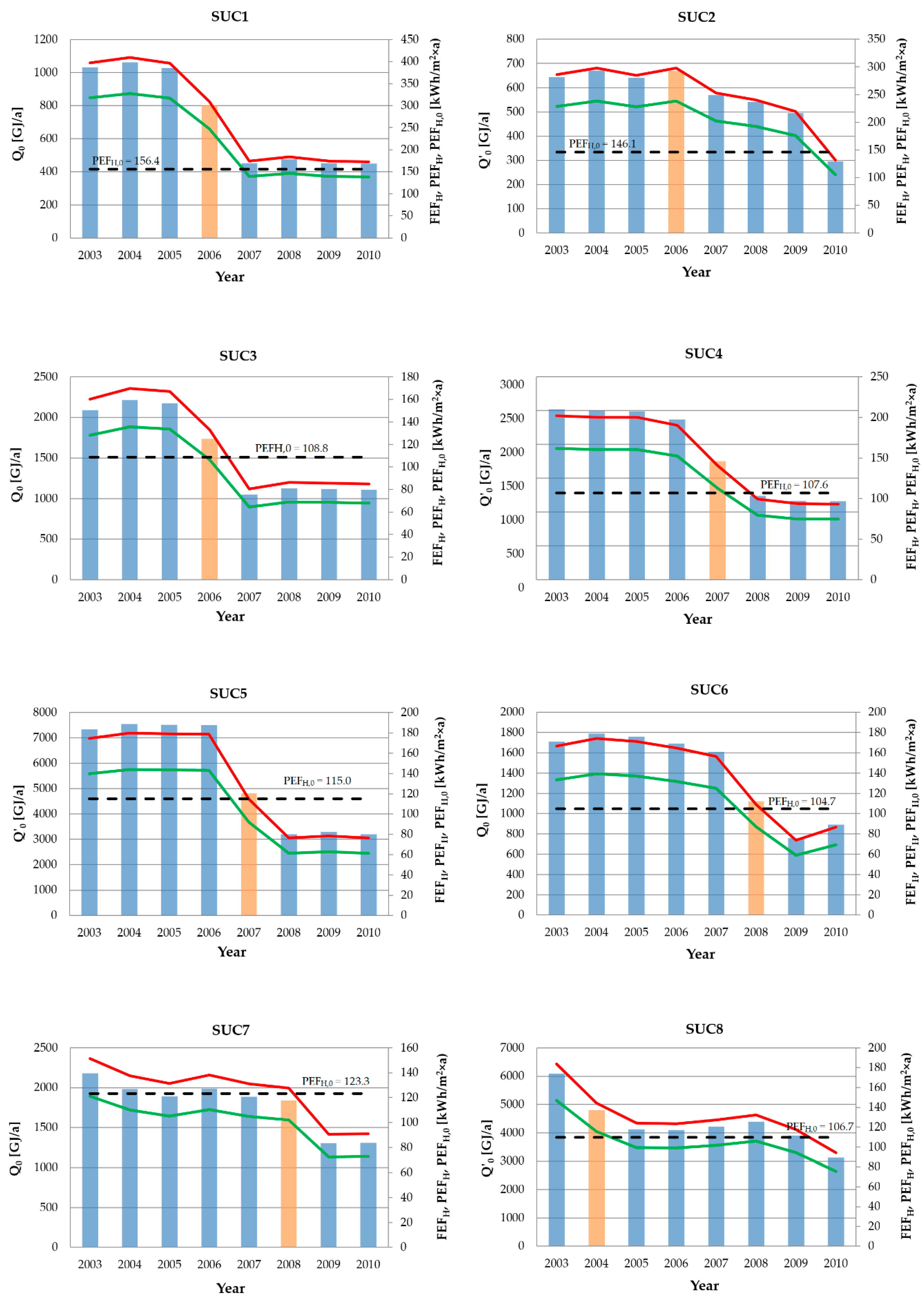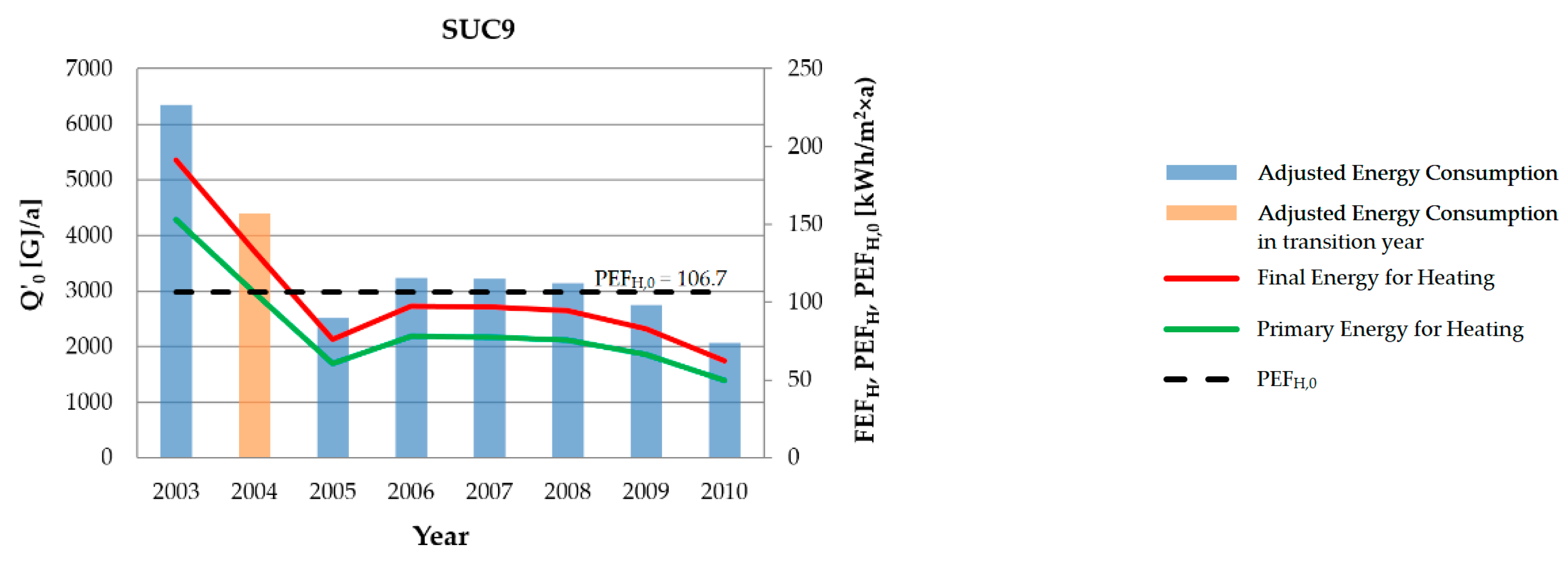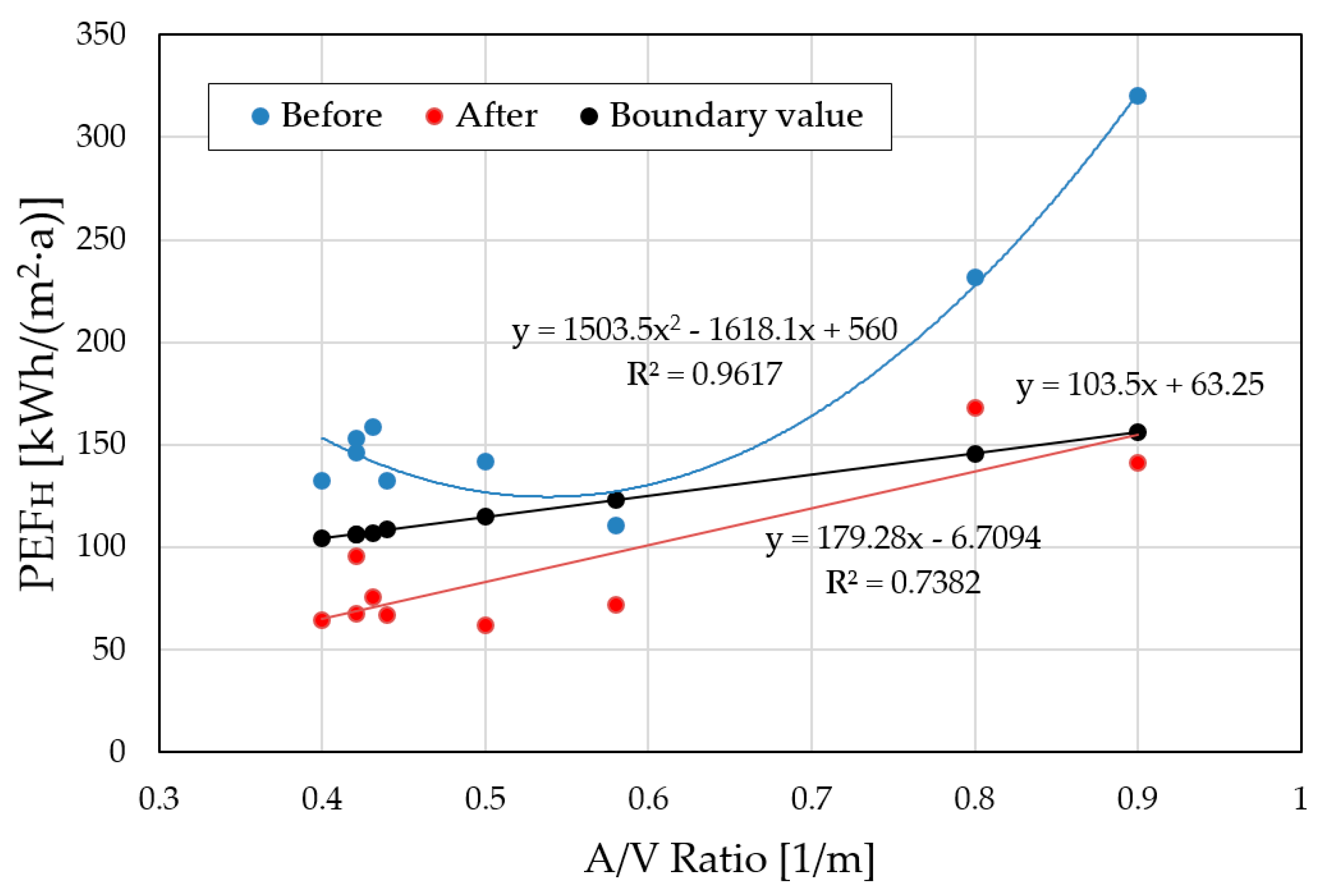Energy Effects of Retrofitting the Educational Facilities Located in South-Eastern Poland
Abstract
1. Introduction
2. Materials and Methods
- Collecting the data from the measurements of legalized heat meters under real conditions for eight years (several years before and several after retrofitting).
- Measurement of the heat consumption for heating purposes in the buildings not equipped with a central hot water installation by means of legalized heat meters installed on the main pipelines of the installation, before the distributors (Qp, GJ/a);
- Measurement of the heat consumption in total for the purposes of heating and hot water preparation in the buildings equipped with a central hot water installation supplied from the heating network (Qp*, GJ/a);
- Measurement of the heat consumption only for the purposes of hot water preparation in June, July, August, (outside the heating season) in the buildings equipped with a central hot water system supplied from the heating network, used to estimate the heat consumption for hot water;
- Estimated heat consumption for hot water (QW, GJ/a) using one of the two methods:
- ○
- for the objects without summer break (SUC2) according to:where:QW = qw,j · dqw,j—unit daily heat consumption for hot water calculated from the measurements during three summer months (June, July, August) in the particular year, GJ/day;d—number of days during the year, 365 days/a.
- ○
- for the objects with summer break (July, August) according to:where:QW = qw,j* · d* + QW*qw,j*—unit daily heat consumption for hot water calculated from the measurements in June in the particular year, GJ/day;d*—number of days during the year without July and August, 303 days/a (10 months);QW*—measured heat consumption for hot water preparation in July and August of the particular year (during 32 days of the year), GJ.
- evaluation of the heat consumption for heating of the building equipped with the hot water system powered from the heating network (Q′p, GJ/a):Q′p = Qp* − QW
- Collecting the data concerning the duration of the heating period and month average temperatures of the outside air.
- Calculation the number of degree-days for each year covered the with analysis according to the following formula:where:Sd—number of degree-days calculated for each year, day·K/a;θe,m—average monthly temperature of outdoor air for the particular year, °C;θint,,H—temperature of indoor air in the heating zone, established 20 °C;Ldm—number of heating days in the particular month for each year, day.
- Calculation of correction factor resulting from the variation of degree-day according to the following dependence:where:φ—correction coefficient;Sd0—number of degree-days in standard year, calculated for the standard year using average month outdoor air temperatures from multi-year measurement and theoretical duration of the heating period (222 days), which equals 3825.2 day∙K/a for the location of the analyzed buildings (constant value for the considered location).Table 2 presents values of correction factor calculated using Equation (5).
- Correction of the measured values to the standard year according to the following formulas:where:Q0–Adjusted Annual Energy Consumption (under standard conditions), GJ/a;Q′0–Adjusted Annual Energy Consumption (under standard conditions) in the buildings with the hot water system powered from the heating network, GJ/a;Qp–measured annual energy consumption, GJ/a;Q′p–estimated annual energy consumption in the buildings with the hot water system powered from the heating network, GJ/a.
- Determination of the Annual Final Energy Factor for Heating (FEFH) according to the following relation:orwhere:FEFH—Final Energy Factor for Heating (FEFH), kWh/(m2·a);Af—usable heating area of the building, m2.
- Determination of the Annual Primary Energy Factor for Heating (PEFH) according to the following relation:where:PEFH = wH FEFH
- Calculation of the boundary value of the Annual Primary Energy Factor for Heating (PEFH,0) in relation to the Building Shape Factor, according to the national (Polish) requirements from the period when thermo-modernization was carried out, according to the relation [27]:where:PEFH,0 = 1.15 · [55 + 90 · (A/V)]PEFH,0—maximal value of the Annual Primary Energy Factor for Heating (PEFH), kWh/(m2·a);A/V—Building Shape Factor–ratio between the sums of the areas of building boundaries serving the balance cover and heated volume of the building measured in outer contour, 1/m.
- Determination of the energy consumption savings according to the following dependences:ΔQ%,avg = (Q01,avg − Q02,avg)/Q01,avg · 100ΔQ%,min = (Q01,avg − Q02,min)/Q01,avg · 100where:ΔQ%,max = (Q01,avg − Q02,max)/Q01,avg · 100ΔQ%,avg, ΔQ%,min, ΔQ%,max—average, minimal and maximal (respectively) obtained decrease of Annual Energy consumption after thermo-modernization related to the annual value of the average Annual Energy Consumption before thermo-modernization, %;Q01,avg—average Annual Energy Consumption before thermo-modernization reduced to the standard conditions, GJ/a;Q02,avg, Q02,min, Q02,max—average, minimal and maximal (respectively) Annual Energy Consumption after thermo-modernization reduced to the standard conditions, GJ/a.
3. Results
3.1. Readouts of Energy Consumption
3.2. Calculation of the Thermo-Modernization Efficiency
3.2.1. Evaluation of the Boundary Value of the Annual Primary Energy Factor for Heating
3.2.2. Evaluation of Annual Energy Consumption and Energy Factors for Heating
4. Discussion
5. Conclusions
- Under the operating conditions, the state calculated theoretically is not obtained. The actual energy consumption decreases are much lower than predicted, which mainly results from the improvement of thermal comfort in the rooms of the building.
- In the cases analyzed, the energy consumption under operating conditions decreased in the range of 34%–56%, which gave an average decrease in heat consumption of 46.8%.
- For better building energy management, the heat consumption for heating and hot water production should be monitored separately.
- In the buildings with identical shape factors and a similar manner of use, different energy effects are obtained under operating conditions.
- The efficiency of thermo-modernization in the case of the buildings with a simple shape was better compared to the objects with a higher A/V ratio.
Author Contributions
Funding
Conflicts of Interest
References
- Moretti, E.; Barbanera, M.; Foschini, D.; Buratti, C.; Cotana, F. Energy and environmental performance analysis of biomass-fuelled combined cooling and heating system for commercial building retrofit: An Italian case study. Energy Procedia 2016, 101, 376–383. [Google Scholar] [CrossRef]
- European Union. EU Energy in Figures, Statistical Pocketbook. 2012. Available online: https://op.europa.eu/en/publication-detail/-/publication/4fbba65f-6690-4c3f-878a-e4ce0bc3515c (accessed on 4 May 2020).
- Saheb, Y.; Bodis, K.; Szabo, S.; Ossenbrink, H.; Panev, S. Energy Renovation: The Trump Card for the New Start for Europe; Publications Office of the European Union: Luxembourg, 2015. [Google Scholar]
- Tettey, U.Y.A.; Dodoo, A.; Gustavsson, L. Effect of different frame materials on the primary energy use of a multi storey residential building in a life cycle perspective. Energy Build. 2019, 185, 259–271. [Google Scholar] [CrossRef]
- Aste, N.; Del Pero, C. Impact of domestic and tertiary buildings heating by natural gas in the Italian context. Energy Policy 2012, 47, 164–171. [Google Scholar] [CrossRef]
- Le Truong, N.; Gustavsson, L. Costs and primary energy use of heating new residential areas with district heat or electric heat pumps. Energy Procedia 2019, 158, 2031–2038. [Google Scholar] [CrossRef]
- Directive 2010/31/EU of the European Parliament and of the Council of 19 May 2010 on the Energy Performance of Buildings. Available online: https://eur-lex.europa.eu/legal-content/EN/TXT/?uri=CELEX%3A32010L0031 (accessed on 4 May 2020).
- Piccardo, C.; Dodoo, A.; Gustavsson, L.; Tettey, U.Y.A. Retrofitting with different building materials: Life-cycle primary energy implications. Energy 2020, 192, 116648. [Google Scholar] [CrossRef]
- Pardo-Bosch, F.; Cervera, C.; Ysa, T. Key aspects of building retrofitting: Strategizing sustainable cities. J. Environ. Manag. 2019, 248, 109247. [Google Scholar] [CrossRef]
- Cho, K.H.; Kim, S.S. Energy performance assessment according to data acquisition levels of existing buildings. Energies 2019, 12, 1149. [Google Scholar] [CrossRef]
- Directive 2002/91/EC of the European Parliament and of the Council of 16 December 2002 on the Energy Performance of Buildings. Available online: https://eur-lex.europa.eu/legal-content/EN/TXT/?uri=CELEX%3A32002L0091 (accessed on 4 May 2020).
- Act of Polish Government of 18 December 1998 on Supporting Thermomodernization Projects. Available online: http://prawo.sejm.gov.pl/isap.nsf/DocDetails.xsp?id=WDU19981621121 (accessed on 4 May 2020).
- Regulation of the Polish Minister of Interior and Administration of 30 April 1999 Concerning Scope and Form of the Energy Audit as Well as Algorithms for Assessing the Profitability of Thermo-Modernization Project and the Patterns of the Energy Audit Cards. Available online: http://prawo.sejm.gov.pl/isap.nsf/DocDetails.xsp?id=WDU19990460459 (accessed on 4 May 2020).
- Wojdyga, K.; Chorzelski, M. Chances for Polish district heating systems. Energy Procedia 2017, 116, 106–118. [Google Scholar] [CrossRef]
- Woroniak, G.; Piotrowska-Woroniak, J. Effects of pollution reduction and energy consumption reduction in small churches in Drohiczyn community. Energy Build. 2014, 72, 51–61. [Google Scholar] [CrossRef]
- Mavromatidis, L.E.; Bykalyuk, A.; Lequay, H. Development of polynomial regression models for composite dynamic envelopes thermal performance forecasting. Appl. Energy 2013, 104, 379–391. [Google Scholar] [CrossRef]
- Życzyńska, A. The heat consumption and heating costs after the insulation of building partitions of building complex supplied by the local oil boiler room. Eksploatacja Niezawodnosc 2014, 16, 313–318. [Google Scholar]
- El-Darwish, I.; Gomaa, M. Retrofitting strategy for building envelopes to achieve energy efficiency. Alex. Eng. J. 2017, 56, 579–589. [Google Scholar] [CrossRef]
- Fan, Y.; Xia, X. A multi-objective optimization model for energy-efficiency building envelope retrofitting plan with rooftop PV system installation and maintenance. Appl. Energy 2017, 189, 327–335. [Google Scholar] [CrossRef]
- Song, X.; Ye, C.; Li, H.; Wang, X.; Ma, W. Field study on energy economic assessment of office buildings envelope retrofitting in southern China. Sustain. Cities Soc. 2017, 28, 154–161. [Google Scholar] [CrossRef]
- Fabrizio, E.; Ferrara, M.; Monetti, V. Smart heating systems for cost-effective retrofitting. In Cost-Effective Energy Efficient Building Retrofitting, Materials, Technologies, Optimization and Case Studies, 1st ed.; Pacheco-Torgal, F., Granqvist, C., Jelle, B., Vanoli, G., Bianco, N., Kurnitski, J., Eds.; Elsevier: Amsterdam, The Netherlands, 2017. [Google Scholar] [CrossRef]
- Wang, Q.; Holmberg, S. Combined retrofitting with low temperature heating and ventilation energy savings. Energy Procedia 2015, 78, 1081–1086. [Google Scholar] [CrossRef][Green Version]
- Życzyńska, A. The influence of heating and hot water system on the energy performance of a building. Rynek Energii 2009, 6, 46–54. [Google Scholar]
- Życzyńska, A. The primary energy factor for the urban heating system with the heat source working in association. Eksploatacja Niezawodnosc 2013, 15, 458–462. [Google Scholar]
- Regulation of the Polish Minister of Infrastructure of 6 November 2008 Concerning the Methodology for Calculating the Energy Performance of the Building and a Residential Unit or Part of a Building Which Is the Whole Technical-Independent Utility and the Preparation and Presentation of Certificates of Energy Performance. Available online: http://isap.sejm.gov.pl/DetailsServlet?id=WDU20082011240 (accessed on 4 May 2020).
- Regulation of the Polish Minister of Infrastructure of 17 March 2009 Concerning Scope and Form of the Energy Audit and the Repair Audit, Design Audits Cards, as Well as Algorithms for Assessing the Profitability of Thermo-Modernization Project. Available online: http://isap.sejm.gov.pl/DetailsServlet?id=WDU20090430347 (accessed on 4 May 2020).
- Regulation of the Minister of Infrastructure of 6 November 2008. Amending the Regulation on the Technical Conditions to Be Met by Buildings and Their Location. Available online: http://prawo.sejm.gov.pl/isap.nsf/DocDetails.xsp?id=WDU20082011238 (accessed on 4 May 2020).
- Regulation of the Polish Minister of Infrastructure of 27 February 2015 Concerning the Methodology for Calculating the Energy Performance of the Building or Part of a Building and the Preparation of Certificates of Energy Performance. Available online: http://prawo.sejm.gov.pl/isap.nsf/DocDetails.xsp?id=WDU20150000376 (accessed on 4 May 2020).
- Pereira, L.D.; Raimondo, D.; Corgnati, S.P.; Gameiro Da Silva, M. Energy consumption in schools—A review paper. Renew. Sustain. Energy Rev. 2014, 40, 911–922. [Google Scholar] [CrossRef]
- Marrone, P.; Gori, P.; Asdrubali, F.; Evangelisti, L.; Calcagnini, L.; Grazieschi, G. Energy benchmarking in educational buildings through cluster analysis of energy retrofitting. Energies 2018, 11, 649. [Google Scholar] [CrossRef]
- Mazzola, E.; Dalla Mora, T.; Peron, F.; Romagnoni, P. An integrated energy and environmental audit process for historic buildings. Energies 2019, 12, 3940. [Google Scholar] [CrossRef]
- Biserni, C.; Valdiserri, P.; D’Orazio, D.; Garai, M. Energy retrofitting strategies and economic assessments: The case study of a residential complex using utility bills. Energies 2018, 11, 2055. [Google Scholar] [CrossRef]
- Mancini, F.; Nastasi, B. Energy retrofitting effects on the energy flexibility of dwellings. Energies 2019, 12, 2788. [Google Scholar] [CrossRef]
- Zender-Swiercz, E.; Telejko, M. Impact of insulation building on the work of ventilation. Procedia Eng. 2016, 161, 1731–1737. [Google Scholar] [CrossRef][Green Version]
- Gładyszewska-Fiedoruk, K. Correlations of air humidity and carbon dioxide concentration in the kindergarten. Energy Build. 2013, 62, 45–50. [Google Scholar] [CrossRef]




| Object | Construction Year | Technology of Construction | A/V | Heated, Usable Area [m2] | Retrofitting Year | Energy Needs |
| SUC1 | 1968 | traditional | 0.90 | 721 | 2006 | heating |
| SUC2 | 1981 | industrialized | 0.80 | 625 | 2007 | heating + hot water |
| SUC3 | 1970 | industrialized | 0.44 | 3624 | 2006 | heating |
| SUC4 | 1963 | traditional | 0.43 | 3458 | 2007 | heating + hot water |
| SUC5 | 1985 | industrialized | 0.50 | 11,654 | 2007 | heating + hot water |
| SUC6 | 1961 | traditional | 0.40 | 2855 | 2008 | heating |
| SUC7 | 1974 | industrialized | 0.58 | 4000 | 2008 | heating |
| SUC8 | 1982 | industrialized | 0.42 | 9216.2 | 2004 | heating + hot water |
| SUC9 | 1983 | industrialized | 0.42 | 9216.2 | 2004 | heating + hot water |
| Before Retrofitting | After Retrofitting | |||||
| Object | Uwalls [W/m2K] | Uroof/Uflat roof [W/m2K] | Uwindow/Udoor [W/m2K] | Uwalls [W/m2K] | Uroof/Uflat roof [W/m2K] | Uwindow/Udoor [W/m2K] |
| SUC1 | 0.95 ** | 1.28 ** | 2.6/2.5 ** | 0.24 ** | 0.22 ** | 1.8/1.8 ** |
| SUC2 | 1.16 *** | 0.70 *** | 3.0/5.6 | 0.25 * | 0.22 * | 1.8/1.8 * |
| SUC3 | 1.12 | 0.85 | 5.1/3.5 | 0.25 * | 0.22 * | 1.8/1.8 * |
| SUC4 | 1.16 *** | 0.70 *** | 5.6/5.6 | 0.25 * | 0.22 * | 1.8/1.8 * |
| SUC5 | 1.13 | 0.85 | 2.6/2.5 | 0.25* | 0.22 * | 1.8/1.8 * |
| SUC6 | 1.16 *** | 0.70 *** | 3.0/5.6 | 0.25 * | 0.22 * | 1.8/1.8 * |
| SUC7 | 1.16 *** | 0.70 *** | 3.0/5.6 | 0.25* | 0.22 * | 1.8/1.8 * |
| SUC8 | 1.12 ** | 1.54/2.37 ** | 2.8/5.6 ** | 0.24 ** | 0.21/0.22 ** | 1.3/1.3 ** |
| SUC9 | 1.12 ** | 1.54/2.37 ** | 2.8/5.6 ** | 0.24 ** | 0.21/0.22 ** | 1.3/1.3 ** |
| Year | Sd0 | Sd | φ |
|---|---|---|---|
| 2003 | 3825.2 | 3938.3 | 0.971 |
| 2004 | 3714.7 | 1.030 | |
| 2005 | 3844.5 | 0.995 | |
| 2006 | 3788.8 | 1.010 | |
| 2007 | 3677.4 | 1.040 | |
| 2008 | 3542.5 | 1.080 | |
| 2009 | 3669.2 | 1.043 | |
| 2010 | 4263.9 | 0.897 |
| Year | SUC1 | SUC2 | SUC3 | SUC4 | SUC5 | SUC6 | SUC7 | SUC8 | SUC9 |
|---|---|---|---|---|---|---|---|---|---|
| 2003 | 1062 | 662.98 | 2153 | 2592 | 7550.34 | 1761.8 | 2245.9 | 6273 | 6531.9 |
| 2004 | 1031.2 | 650.36 | 2148.8 | 2421.4 | 7323.28 | 1736 | 1924.6 | 4651.5 * | 4274.8 * |
| 2005 | 1032.4 | 643.6 | 2189.2 | 2505.6 | 7556.95 | 1768.3 | 1901.3 | 4143.9 | 2536 |
| 2006 | 794.5 * | 663 | 1716.7 * | 2347.9 | 7425.35 | 1675.5 | 1968.1 | 4058.4 | 3201.4 |
| 2007 | 434.4 | 546.9 * | 1010.8 | 1683.9 * | 4636.12 * | 1544.3 | 1816.2 | 4056.2 | 3101.9 |
| 2008 | 441 | 501.4 | 1042.25 | 1146.9 | 2970.3 | 1038.3 * | 1701.6 * | 4064.9 | 2910.1 |
| 2009 | 434.2 | 473.8 | 1071.4 | 1118.4 | 3153.72 | 727.4 | 1251.1 | 3742.2 | 2641.8 |
| 2010 | 500 | 329.5 | 1235.8 | 1295.4 | 3575.89 | 993.7 | 1460.1 | 3485.5 | 2313.8 |
| SUC1 | SUC2 | SUC3 | SUC4 | SUC5 | SUC6 | SUC7 | SUC8 | SUC9 | |
|---|---|---|---|---|---|---|---|---|---|
| PEFH,0 [kWh/(m2·a)] | 156.4 | 146.1 | 108.8 | 107.6 | 115.0 | 104.7 | 123.3 | 106.7 | 106.7 |
| SUC1 | SUC2 | |||||
| Year | Q0(Q′0) [GJ/a] | FEFH [kWh/m2a] | PEFH [kWh/m2a] | Q0(Q′0) [GJ/a] | FEFH [kWh/m2a] | PEFH [kWh/m2a] |
| 2003 | 1031.2 | 397.29 | 317.83 | 643.8 | 286.11 | 228.89 |
| 2004 | 1062.1 | 409.21 | 327.37 | 669.9 | 297.72 | 238.18 |
| 2005 | 1027.2 | 395.76 | 316.61 | 640.4 | 284.61 | 227.69 |
| 2006 | 802.4 * | 309.16 * | 247.32 * | 669.6 | 297.61 | 238.09 |
| 2007 | 451.8 | 174.05 | 139.24 | 568.8 * | 252.79 * | 202.23 * |
| 2008 | 476.3 | 183.50 | 146.80 | 541.5 | 240.67 | 192.54 |
| 2009 | 452.9 | 174.48 | 139.58 | 494.2 | 219.63 | 175.71 |
| 2010 | 448.5 | 172.79 | 138.23 | 295.6 | 131.36 | 105.09 |
| SUC3 | SUC4 | |||||
| Year | Q0(Q′0) [GJ/a] | FEFH [kWh/m2a] | PEFH [kWh/m2a] | Q0(Q′0) [GJ/a] | FEFH [kWh/m2a] | PEFH [kWh/m2a] |
| 2003 | 2090.6 | 160.24 | 128.19 | 2516.8 | 202.17 | 161.74 |
| 2004 | 2213.3 | 169.65 | 135.72 | 2494.0 | 200.34 | 160.28 |
| 2005 | 2178.3 | 166.96 | 133.57 | 2493.1 | 200.27 | 160.21 |
| 2006 | 1733.9 * | 132.90 * | 106.32 * | 2371.4 | 190.49 | 152.39 |
| 2007 | 1051.2 | 80.58 | 64.46 | 1751.3 * | 140.68 * | 112.54 * |
| 2008 | 1125.6 | 86.28 | 69.02 | 1238.7 | 99.50 | 79.60 |
| 2009 | 1117.5 | 85.65 | 68.52 | 1166.5 | 93.70 | 74.96 |
| 2010 | 1108.5 | 84.97 | 67.97 | 1162.0 | 93.34 | 74.67 |
| SUC5 | SUC6 | |||||
| Year | Q0(Q′0) [GJ/a] | FEFH [kWh/m2a] | PEFH [kWh/m2a] | Q0(Q′0) [GJ/a] | FEFH [kWh/m2a] | PEFH [kWh/m2a] |
| 2003 | 7331.4 | 174.75 | 139.80 | 1710.7 | 166.44 | 133.15 |
| 2004 | 7543.0 | 179.79 | 143.83 | 1788.1 | 173.97 | 139.18 |
| 2005 | 7519.2 | 179.22 | 143.38 | 1759.5 | 171.19 | 136.95 |
| 2006 | 7499.6 | 178.76 | 143.00 | 1692.3 | 164.65 | 131.72 |
| 2007 | 4821.6 * | 114.92 * | 91.94 * | 1606.1 | 156.26 | 125.01 |
| 2008 | 3207.9 | 76.46 | 61.17 | 1121.4 * | 109.10 * | 87.28 * |
| 2009 | 3289.3 | 78.40 | 62.72 | 758.7 | 73.82 | 59.05 |
| 2010 | 3207.6 | 76.45 | 61.16 | 891.3 | 86.72 | 69.38 |
| SUC7 | SUC8 | |||||
| Year | Q0(Q′0) [GJ/a] | FEFH [kWh/m2a] | PEFH [kWh/m2a] | Q0(Q′0) [GJ/a] | FEFH [kWh/m2a] | PEFH [kWh/m2a] |
| 2003 | 2180.8 | 151.44 | 121.15 | 6091.1 | 183.59 | 146.87 |
| 2004 | 1982.3 | 137.66 | 110.13 | 4791.0 * | 144.40 * | 115.52 * |
| 2005 | 1891.8 | 131.37 | 105.10 | 4123.2 | 124.27 | 99.42 |
| 2006 | 1987.8 | 138.04 | 110.43 | 4099.0 | 123.54 | 98.84 |
| 2007 | 1888.8 | 131.17 | 104.94 | 4218.4 | 127.14 | 101.72 |
| 2008 | 1837.7 * | 127.62 * | 102.10 * | 4390.1 | 132.32 | 105.85 |
| 2009 | 1304.9 | 90.62 | 72.49 | 3903.1 | 117.64 | 94.11 |
| 2010 | 1309.7 | 90.95 | 72.76 | 3126.5 | 94.23 | 75.39 |
| SUC9 | ||||||
| Year | Q0(Q′0) [GJ/a] | FEFH [kWh/m2a] | PEFH [kWh/m2a] | |||
| 2003 | 6342.5 | 191.16 | 152.93 | |||
| 2004 | 4403.0 * | 132.71 * | 106.17 * | |||
| 2005 | 2523.3 | 76.05 | 60.84 | |||
| 2006 | 3233.4 | 97.46 | 77.96 | |||
| 2007 | 3226.0 | 97.23 | 77.79 | |||
| 2008 | 3142.9 | 94.73 | 75.78 | |||
| 2009 | 2755.4 | 83.05 | 66.44 | |||
| 2010 | 2075.5 | 62.56 | 50.04 | |||
| Object | Q0 before [GJ/a] | Q0 Transition Year [GJ/a] | Q0 after [GJ/a] | ΔQ%,avg [%] | ΔQ%,min [%] | ΔQ%,max [%] |
|---|---|---|---|---|---|---|
| SUC1 | 1040.2 | 802.0 | 457.4 | 56.0 | 54.2 | 56.9 |
| SUC2 | 651.3 | 568.5 | 295.6 | 54.6 | - | - |
| SUC3 | 2160.7 | 1733.9 | 1100.7 | 49.1 | 47.9 | 51.3 |
| SUC4 | 2468.8 | 1751.3 | 1189.0 | 51.8 | 49.8 | 52.9 |
| SUC5 | 7473.3 | 4821.6 | 3234.9 | 56.7 | 56.0 | 57.1 |
| SUC6 | 1711.3 | 1121.4 | 825.0 | 51.8 | 47.9 | 55.7 |
| SUC7 | 1986.3 | 1837.7 | 1307.3 | 34.2 | 34.1 | 34.3 |
| SUC8 | 6091.1 | 4791.0 | 3976.7 | 34.7 * | 27.9 * | 48.7 * |
| SUC9 | 6342.5 | 4403.0 | 2826.1 | 55.4 * | 49.0 * | 67.3 * |
| Object | Q before [GJ/a] | Q after [GJ/a] | Energy Savings [%] |
|---|---|---|---|
| SUC1 | 1324.9 | 395.0 | 70.2 |
| SUC8 | 9373.7 | 1662.6 | 82.3 |
| SUC9 | 8472.4 | 1487.5 | 82.4 |
© 2020 by the authors. Licensee MDPI, Basel, Switzerland. This article is an open access article distributed under the terms and conditions of the Creative Commons Attribution (CC BY) license (http://creativecommons.org/licenses/by/4.0/).
Share and Cite
Życzyńska, A.; Suchorab, Z.; Kočí, J.; Černý, R. Energy Effects of Retrofitting the Educational Facilities Located in South-Eastern Poland. Energies 2020, 13, 2449. https://doi.org/10.3390/en13102449
Życzyńska A, Suchorab Z, Kočí J, Černý R. Energy Effects of Retrofitting the Educational Facilities Located in South-Eastern Poland. Energies. 2020; 13(10):2449. https://doi.org/10.3390/en13102449
Chicago/Turabian StyleŻyczyńska, Anna, Zbigniew Suchorab, Jan Kočí, and Robert Černý. 2020. "Energy Effects of Retrofitting the Educational Facilities Located in South-Eastern Poland" Energies 13, no. 10: 2449. https://doi.org/10.3390/en13102449
APA StyleŻyczyńska, A., Suchorab, Z., Kočí, J., & Černý, R. (2020). Energy Effects of Retrofitting the Educational Facilities Located in South-Eastern Poland. Energies, 13(10), 2449. https://doi.org/10.3390/en13102449







